 1. Basic information.
1. Basic information.
1.1. Terminology.
There are multiple terms and names given to specific concepts that are important to know while hunting, interacting with other hunters, and reading guides.
Target: the Pokémon you aim to get the shiny version of.
-
Phase: When you are hunting and find a Shiny Pokémon that is not your target, you advance one phase. For example, being on phase three would mean that you have previously found two other shinies that weren’t your target.
Full odds: when the shiny odds are not modified in any way by methods. Under regular conditions, the normal shiny odds in all Gen 1 to 5 games are 1 in 8192.
-
Shiny Charm: a key item that adds additional personality values, which essentially gives extra tries to roll for a Shiny Pokémon. This effect can be stacked with other bonuses, like breeding with the Masuda Method. The only games where it’s available prior to Gen 6 are Black 2 and White 2, obtainable by completing the entire National Pokédex (except Mythical Pokémon). In these games, it adds two extra rolls, making the odds 3 in 8192 (around 1 in 2731), but it does not affect Pokémon received from NPCs or Mystery Gift events. The Shiny Charm cannot be deactivated.
-
SR (Soft-Reset): a button combination that lets you reset the game without turning off the console. It is useful for hunting for interactable Pokémon found in the overworld, like the sleeping Snorlax in Kanto or most legendary Pokémon.
Game Button combination Gameboy, Gameboy Color, and Gameboy Advance games A + B + START + SELECT Pokémon Colosseum There's no button combination. Reset the GameCube with the built-in RESET button. Pokémon XD: Gale of Darkness B + X + START DS games L + R + START + SELECT Wii games There’s no button combination. Reset the game with the Wiimote Home button → Reset. Virtual Console games A + B + START + SELECT or by resetting through the Vritual Console menu. RE (Random Encounter): moving around an area to force wild Pokémon to appear. This can take place in grass, water, caves, etc.
-
Repel trick: Pokémon repels let you avoid any wild Pokémon as long as they are a lower level than the first Pokémon in your party, while the ones at the same level or higher will be able to appear normally. If you use a level 50 Pokémon, anything lower than 50 won’t be able to appear in a battle for as long as the repel lasts.
This strategy can be used to increase and decrease the chance of specific Pokémon appearing, which aims to make some targets easier to hunt (or not as tedious). These repel tricks can also be combined with some abilities like Magnet Pull or Static. For example, in Pokémon Emerald, Route 113 has a 5% chance for Skarmory to appear, and, while a level 16 Repel Trick can bring it up to 25%, it’s not as efficient as the 87.5% chance when you add Magnet Pull to the mix.
The only downside to Repel Tricks is the influence they have on the encounter rate, making wild encounters slower, and although this is sometimes barely noticeable, it can be very significant most of the time. The best way to find the best repel trick is by using AngefloSH’s Pokémon Encounter Calculator.
-
Shiny Lock: when the shiny version of a Pokémon is made unavailable in a game. This means that no matter how many times you reset to find it, it will never be able to shine. Some examples of this are legendary Pokémon like Zekrom and Reshiram in Black and White, or most mythical Pokémon. These locks are usually intended and created by the game developers, like the Shadow Pokémon in XD: Gale of Darkness. Some codes and game modifications have been created in order to break these shiny locks, especially for popular targets like Victini.
-
Shiny Quests: challenges where you have to get a certain amount of Shiny Pokémon, a specific team of shinies, and more. These quests are usually used as motivation to get into a hunt or search for targets you normally wouldn't consider. If you can’t come up with one, there are multiple premade challenges made by others, and you are free to make and change your own rules. Here are some examples:
-
SBQ (Shiny Badge Quest): a challenge where you get a Shiny Pokémon before receiving each gym badge. In most games, this means you usually get a total of 8 shinies before beating the Pokémon League, with the exception of Heart Gold and Soul Silver, where you may add the extra 8 Kanto badges for a total of 16 Pokémon.
-
DTQ (dream team quest): a challenge where you get a team of specific Shiny Pokémon (usually the ones that you like the most) to beat the game’s story with. This means that you may need to phase in order to achieve this, while on an SBQ, you can take what you find. On the other hand, you are not tied to getting a shiny before certain points of the game, so you have a little more freedom on when to hunt.
-
Monotype Run: similar to a DTQ, but with the extension of all Shiny Pokémon sharing one type. Planning the targets as thoroughly as a DTQ may not be needed on some occasions, but you will probably have to check the availability of the Pokémon of that type in the game’s region before starting (for example, a Dragon Monotype may not be doable in some games due to the scarcity of these Pokémon). Water is a popular type, as it has the highest number of Pokémon and isolated encounters (you will usually only find water-type Pokémon by surfing or fishing).
-
Generational Quest: instead of hunting for a team or a group of Pokémon, here your objective will be finding the shiny version of a single Pokémon in all generations it’s available in. For example, you can hunt Tangela starting from Gen 1, as it is obtainable through an in-game trade, but if you aim to get Nosepass, you will have to start in Gen 3.
-
-
Game name acronyms: an abbreviated version of the name of a game, usually paired with its sibling version.
Game name Shortened version Red, Blue, and Yellow RBY Gold, Silver, and Crystal GSC Ruby, Sapphire, and Emerald RSE FireRed and LeafGreen FRLG Diamond, Pearl, and Platinum DPPt Heart Gold and Soul Silver HGSS Black and White BW Black 2 and White 2 B2W2 -
IV (Individual Value): hidden numbers that affect each of the six main stats of a Pokémon. They are determined when a Pokémon is generated and will range from 0 to 31. IVs are also used to calculate things like the type and power of a Pokémon’s Hidden Power. While IVs are not usually relevant while shiny hunting, there are some occasions where they play an interesting role in some specific hunts.
-
DV (Determinant Value): the Generation 1 and 2 version of the IVs. They have a similar concept, but their range goes from 0 to 15. The most important part about DVs is that they play a crucial role when it comes to generating Shiny Pokémon.
1.2. Notation.
Through this guide, there will be multiple concepts referred to with specific names. The most important are:
-
Interactable Pokémon: a Pokémon that appears in the world as any other NPC and can be interacted with, usually starting a battle. Some examples of these Pokémon are the sleeping Snorlax in Kanto, some legendaries, the Electrodes from Team Rocket’s Johto Hideout, etc. The interactable Pokémon available in each game will be shown in a list in its corresponding section.
-
Received Pokémon: a Pokémon that is obtained through a gift or that is found inside a Poké Ball, an egg, or a fossil. Some examples are the starters in each game, the Eevee given by Bill in Goldenrod City, the Togepi egg from Sevii Island’s Water Labyrinth, the Mirage Tower’s fossils in Hoenn, etc. The received Pokémon available in each game will be shown in a list in its corresponding section.
-
In-game trades: some NPCs will offer you their Pokémon in exchange for one of yours, usually from a specific species. These Pokémon are usually shiny-locked, but in Generation 1, they can be hunted.
-
Roaming Pokémon: a wild legendary Pokémon that, after being activated, will roam the region in a seemingly random way. These Pokémon are able to end the battle at any time and need very specific preparation for both hunting and catching them.
 2. Generations 1 and 2.
2. Generations 1 and 2.
Games and information
Generation 1




Generation 1 doesn't have colour variations, or Shiny Pokémon as we know them, but due to the stats determining this characteristic, they can still have the genes of a Shiny. Hunts work very differently in these games.
Generation 2



The first appearance of Shiny Pokémon as we know it. Stats still determine this trait. There are multiple ways of hunting and oddities that make hunting in these games interesting while keeping you learning new things almost every day.
-Shortened content overview-
Generation 1.
Shininess determined by DVs.
Figuring out Shiny stats.
List of huntable targets.
Transfering to Generation 2.
Transfering to Generation 7.
Generation 2.
List of some huntable targets.
Pokémon with the 7:1 gender ratio.
Shiny Unown limitations.
Wild Pokémon running away.
Eggs, Shiny parents, Odd Egg and the Gyarados diagram.
 3. Generation 3.
3. Generation 3.
Games and information
Hoenn



Hoenn introduced new tools and tech that became the standard for Shiny hunting, as well as a decent amount of unique hunts influenced by the inner workings of the games. There is always something new to hunt in this region.
Kanto


These remakes bring Shiny Pokémon to a new level in the Kanto region while keeping the charm of Generation 3. The varied number of targets and the types of hunts will make you want to come back to them.
Gamecube gamesThe Gamecube is home to two major games where Shiny hunting can get as tough as it can: Colosseum and XD: Gale of Darkness. Shadow Pokémon can be hunted in Colosseum, making them some of the most time-consuming but fulfilling targets of the franchise. On the other hand, in Gale of Darkness, Shadow Pokémon are locked, but that doesn't mean hunting is not allowed; there are multiple targets in gifts, Pokéspots, trades, and more.
As for the other games available on this console, Pokémon Box introduces special egg rewards that can be sent to the main games and checked just once per save file. Pokémon Channel and the Colosseum Bonus Disc also introduce a similar concept with a distribution Jirachi.
-Shortened content overview-
Ruby & Sapphire.
Batteries.
Illuminate and the White Flute.
List of some huntable targets.
FireRed & LeafGreen.
List of some huntable targets.
Unowns and their Shiny odds.
Legendaries.
Game Corner.
Emerald.
Abilities outside of battle.
Emerald’s RNG and how it works.
Ways to circumvent the RNG limitations.
List of some huntable targets.
General information and Gamecube games.
Roamers and the IVs glitch.
Event islands and Altering Cave.
Shiny shadow Pokémon.
Non-shadow Pokémon.
Pokémon Colosseum Bonus Disc and Pokémon Channel Jirachi.
Pokémon Box eggs.
 4. Generation 4.
4. Generation 4.
Games and information
Sinnoh



The Sinnoh games introduced new methods of hunting, including the Masuda method, Poké Radar, and other types of hunts like the Honey Trees or double encounters. A good amount and variety of targets, as well as a decent amount of more obscure hunts.
Johto


The Johto remakes kept bringing new ways of hunting, as well as bringing back some old, well-known types like the Game Corner. Following Pokémon is one of the most beloved mechanics, which let you display and see your Shinies in a new way. Perfect game for new hunters due to the wide variety of beginner-friendly targets, although that doesn't mean it doesn't have its fair amount of tough hunts.
Wii gamesJust like the Gamecube, the Wii has a few games where Shinies can be hunted without needing the main ones. Battle Revolution lets you find them in possesion of other trainers, as well as the special Shiny costumes. Pokémon Rumble adds a new fun and stress-free way to hunt, where multiple Pokémon appear at the same time. Pokémon Mystery Dungeon also makes its appearance, being the first instance of this spin-off saga with Shiny Pokémon.
My Pokémon Ranch works in a similar way to Pokémon Box, although this time it doesn't include any huntable targets. It is still a fun and interactive way to see your Shinies in the big screen.
-Shortened content overview-
Diamond, Pearl, and Platinum.
Poké Radar guide.
Great Marsh.
Double encounters.
List of some huntable targets.
Mass outbreaks.
Honey Trees.
Trophy Garden.
Dual-slot.
Heart Gold & Soul Silver.
Starters.
List of some huntable targets.
Radio sounds.
Safari Zone and skipping days.
Legendaries, Roamers, and the Sinjoh Ruins.
General information and Wii games.
Masuda method.
DNS exploit.
Cute Charm glitch.
Manaphy egg.
Battle Revolution.
Wii Ware games: Pokémon Rumble and Mystery Dungeon Shinies.
My Pokémon Ranch.
 5. Generation 5.
5. Generation 5.
Games and information
Unova


The last of the generations that use the 1 in 8192 odds by default. Black and White introduce multiple new mechanics, like double encounter grass in almost every route, Phenomenon, and even huntable Mystery Gift events. The addition of the Entralink and the White Forest/Black City makes the preparation of some hunts more oriented to multiplayer play.
Unova sequels


The upgraded version of the previous two games. They introduce a different list of targets, as well as upgrading some concepts like the Phenomenon thanks to the introduction of Pass Powers through the Entralink, in exchange for a downgraded White Forest and Black City. The Key System and Funfest Missions also add new depth to some hunts.
-Shortened content overview-
Black & White.
Dark grass and double encounters.
Phenomenon and special Pokémon.
Mass outbreaks.
List of some huntable targets.
Roamers.
Huntable Mystery Gift events.
White Forest and Black City.
Black 2 & White 2.
Dark grass.
Phenomenon and Pass Powers.
Funfest Missions.
New Phenomenon targets.
Nature Preserve.
Key System.
List of some huntable targets.
Huntable events.
Lass Diana.
General information.
DNS exploit.
 6. Other important information.
6. Other important information.
6.1. Guaranteed Shiny Pokémon.
There have been multiple Shiny Pokémon appearing in-game without the need for any external events, like the famous Gyarados from the Lake of Rage. There are other less-known Pokémon like these, some of which are not catchable, but they are still a nice addition to the games.
| Pokémon | Game | Info |
|---|---|---|
 |
GSC | Lake of Rage red Gyarados |
 |
W2 | Given as a gift after defeating Benga in the White Treehollow |
 |
B2 | Given as a gift after defeating Benga in the Black Tower |
 |
B2W2 | After seeing the entire Unova dex and getting access to the Nature Preserve |
 |
FRLG | Can be seen by battling Burglar Jac in the Trainer Tower |
 |
FRLG | Can be seen by battling Twins Jen and Kira in the Trainer Tower |
 |
FRLG | Can be seen by battling Fisherman Kaden in the Trainer Tower |
| Multiple Pokémon from the Pokémon Battle e cards | FRLG | Can only be seen during their respective battles |
6.2. Battle e cards.
Released as an add-on to the Generation 3 games, the Battle e cards can be scanned with an e-Reader to add extra trainer battles. There are 5 sets of cards, but only one was released outside of Japan due to the discontinuation of the e-Reader. Some of these battles include trainers with Shiny Pokémon, although they only appear in the sets only released in Japan.
-
Battle e: Series 1 (exclusive to Ruby and Sapphire). This set also includes special berries. This set was released outside of Japan. Trainers can be fought in a house in Mossdeep City. Some may also appear in the Battle Tower after battling them once.
-
Battle e: Series 2 (exclusive to Ruby and Sapphire). This set also includes special berries. Japanese only. First appearance of Shiny Pokémon. Trainers can be fought in a house in Mossdeep City. Some may also appear in the Battle Tower after battling them once.
-
Colosseum Double Battle e (exclusive to Colosseum). Usable in the Card e Room in Phenac Stadium. Japanese only.
-
Battle e FireRed & LeafGreen (exclusive to FireRed and LeafGreen). Adds trainers to the Trainer Tower. Japanese only. The second and last appearance of Shiny Pokémon.
-
Battle e Emerald (exclusive to Emerald). Adds trainers to the Trainer Hill. Japanese only.
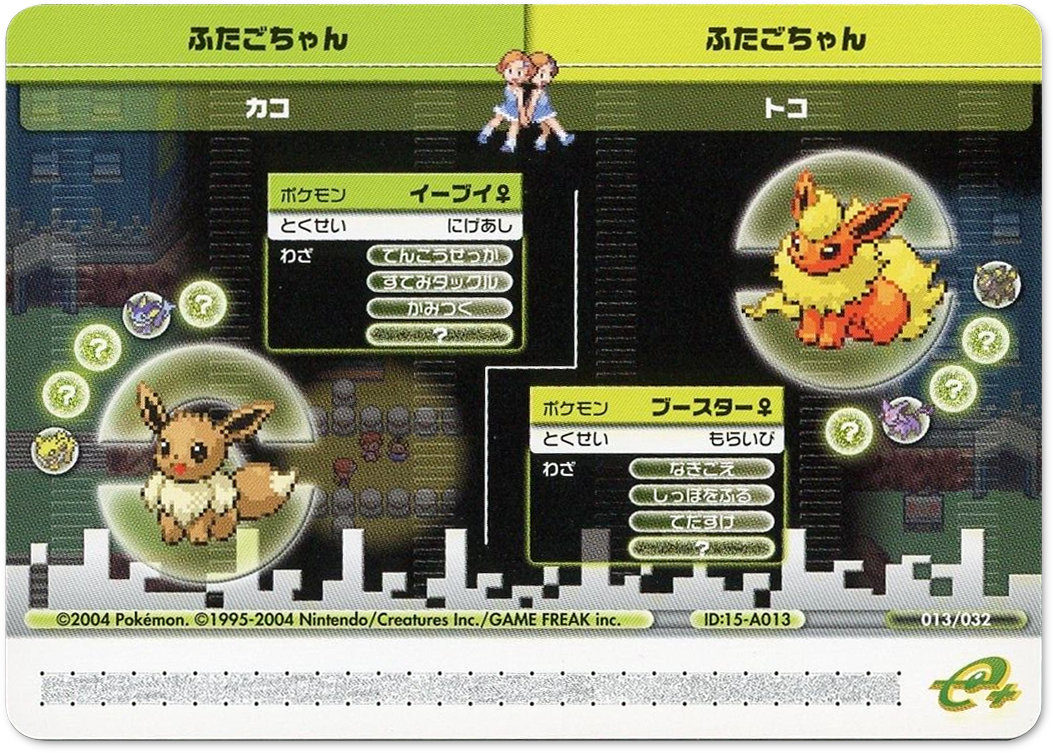
| Trainer | Pokémon | Card ID | Pack |
|---|---|---|---|
| Battle e: Series 2 | |||
| Triathlete Natsuko |  |
08-B020 | Reversal Blow |
| Lady Moet |  |
08-B044 | Steady Power |
| Battle e FireRed & LeafGreen | |||
| Burglar Jac |



|
15-A002 | Red sub-set |
| Twins Jen & Kira |






|
15-A013 | Green sub-set |
| Sailor Brennan |  |
15-A024 | Blue sub-set |
| Fisherman Kaden |



|
||
| Gentleman Emanuel |  |
||
| Super Nerd Owen |



|
15-A026 | Yellow sub-set |
Some of these Pokémon were added to the international versions of the Trainer Tower, specifically Seaking, Meowth, and Espeon, as mentioned previously.
6.3. Ucatchable Shiny Pokémon.
| Pokémon | Game | Info |
|---|---|---|
 |
GSC | Catching tutorial |
 |
FRLG | Catching tutorial |






|
FRLG | Teachy TV |
 |
FRLG | Pokémon Tower Ghost |
 |
RS | Attacks Prof. Birch while choosing the starter |
 |
E | Attacks Prof. Birch while choosing the starter |
 |
RSE | Wally’s catching tutorial |
 |
E | Wally’s catching tutorial |
| Battle Tower Pokémon | RSE | |
| Pokémon that appear in the other facilities of the Battle Frontier | E | |
 |
Colosseum | It counts as a rematch after the Eagun and Cypher Peon Skrub fight |
| Rematch shadow Pokémon | Colosseum | They have a chance to be shiny on the enemy’s side during a rematch |
 |
XD: Gale of Darkness | Appears during the tutorial battle after the intro cutscene |
| Pokémon that appear in the Battle CDs | XD: Gale of Darkness | |
 |
DP | Attacks you while choosing the starter |
| All trainer Pokémon | Battle Revolution | |
| Pokémon that appear in the Battle Frontier | PtHGSS | |
 |
BW | During Prof. Juniper’s intro scene |
 |
BW | Prof. Juniper’s catching tutorial |
 |
BW | Prof. Juniper’s catching tutorial |
 |
B2W2 | During Prof. Juniper’s intro scene |
 |
B2W2 | Bianca’s catching tutorial |
 |
B2W2 | Bianca’s catching tutorial |
6.4. Shiny locks.
Through the generations, Game Freak has left some Shiny Pokémon unobtainable or locked from being hunted (like Victini in Generation 5). This has made a lot of people very angry and has been widely regarded as a bad move. The targets of these locks have usually been mythical Pokémon, some of the rarest Pokémon of the franchise, which have usually been given through events.
- Generation 1.
-



 Wild Pokémon in tall grass, caves, buildings, or surfing.
Wild Pokémon in tall grass, caves, buildings, or surfing.
-
- Generation 2.
-


 Female Pokémon from species with a gender ratio of 1 female to 7 males.
Female Pokémon from species with a gender ratio of 1 female to 7 males.
-
 All Unown forms except I and V.
All Unown forms except I and V.
-

 In-game trades.
In-game trades.
-
- Generation 3.
-

 In-game trades.
In-game trades.
-

 Starter Espeon and Umbreon in Colosseum.
Starter Espeon and Umbreon in Colosseum.
-
 Ducking’s Plusle in Colosseum.
Ducking’s Plusle in Colosseum.
-
 Ho-Oh reward after purifying all Shadow Pokémon in Colosseum.
Ho-Oh reward after purifying all Shadow Pokémon in Colosseum.
-

 Bonus Disc Celebi and Pikachu.
Bonus Disc Celebi and Pikachu.
-

 Shadow Pokémon in XD: Gale of Darkness.
Shadow Pokémon in XD: Gale of Darkness.
-
 Shadow Lugia in XD: Gale of Darkness.
Shadow Lugia in XD: Gale of Darkness.
-
- Generation 4.
-

 In-game trades.
In-game trades.
-
 Pokémon received from the Pokéwalker.
Pokémon received from the Pokéwalker.
-
 Spiky-eared Pichu.
Spiky-eared Pichu.
-

 Gift Shuckle from Cianwood City and Spearow in Goldenrod City.
Gift Shuckle from Cianwood City and Spearow in Goldenrod City.
-
- Generation 5.
-

 In-game trades. Also includes Pokémon given by Yancy/Curtis.
In-game trades. Also includes Pokémon given by Yancy/Curtis.
-

 Gift Eevee from Castelia City and Deerling from the Season Research Labs (Route 6).
Gift Eevee from Castelia City and Deerling from the Season Research Labs (Route 6).
-


 All of N’s Pokémon.
All of N’s Pokémon.
-
 Pokémon from the Dream World and Dream Radar.
Pokémon from the Dream World and Dream Radar.
-

 Pokémon found inside Hidden Grottos.
Pokémon found inside Hidden Grottos.
-
 Gift Zorua from the Game Freak building, during the Celebi event. Also the gift Zorua given by Rood on Driftveil City.
Gift Zorua from the Game Freak building, during the Celebi event. Also the gift Zorua given by Rood on Driftveil City.
-
 Lostlorn Forest Zoroark activated by Shiny Raikou, Entei and Suicune from the HGSS event.
Lostlorn Forest Zoroark activated by Shiny Raikou, Entei and Suicune from the HGSS event.
-


 Reshiram, Zekrom, and Victini.
Reshiram, Zekrom, and Victini.
-
 7. Tips and tricks.
7. Tips and tricks.
7.1. Recommended for beginners.
The best way to get started in the world of old-generation Shiny Hunting is by doing one of the easier hunts available in these games. This way, you can start building confidence towards the slower full-odds targets. Luckily, every generation has their fair share of beginner-friendly hunts with very different styles.
Before going into each generation one by one, there are some things that need to be pointed out. There is no "better" generation to hunt in; being open to testing multiple games and strategies can change the perspective in which you approach the hunts. Limiting yourself to a specific generation may keep you away from a potential new love in another generation you never tried! It’s better to try things before finding the game that you feel most comfortable with. Have prejudices towards Generation 2 for being old? That may be part of the charm that keeps you coming back to it. Reluctant to try Generation 3 because of the "lack" of methods? You may be surprised by how fast most hunts are in those games. Hate Generation 5 because Timmy scammed you in school after he promised you that his Pansage was "absolutely rare and unique", making you trade it for your precious Tirtouga, only to realise that Pansage appears in shaking grass? Honestly, that’s fair; everyone hates Timmy. But still, you may find a new interest if you give it a try.
Another important thing is that, even though they are not always the fastest, starter hunts are some of the best to gain motivation for more hunts after obtaining them. There’s something special about playing through a game with a Shiny Starter.
-
Generation 1.
- Legendary Pokémon. They appear at a higher level than most Pokémon, letting you calculate their stats much more easily than if you needed to level them up beforehand.
-
Generation 2.
- Game Corner targets can be bought multiple times. Some of them are cheap enough to let you fill your entire team and check at least 5 Pokémon per reset.
-
Generation 3.
-
Hoenn Starters. The reset length is one of the shortest (if not the shortest) out of all of the starters in all games. This comes with the downside of finding an uncatchable Shiny during the process.
-
Runaway Emerald targets. Not needing to reset each time makes the flow of the hunt a bit faster than usual in some cases.
-
Safari Zone. Both the Hoenn and Kanto Safari Zones have the fastest encounters of all the games. The wild encounters in Generation 3 are the fastest by default, but add to that not having to throw your Pokémon into battle. There are multiple targets that should be easy to find and catch (like Mareep in Emerald’s Safari extension while using Static).
-
-
Generation 4.
-
Eterna Forest double encounters in Sinnoh, which can be done early in the story and have a decent variety of targets. All the other locations with double encounters are also good, but may require a bit more setup.
-
Johto Starters in Heart Gold and Soul Silver. Seeing three targets per try, with a relatively short reset length, makes these Pokémon some of the most prefered hunts among new hunters.
-
Game Corner targets in Heart Gold and Soul Silver that can be bought multiple times. Some of them are cheap enough to let you fill your entire team and check at least 5 Pokémon per reset.
-
-
Generation 5.
- Any place that has dark grass for potential double encounters.
7.2. Useful tools.
-
Counter.
The number of encounters and resets during a hunt in these games can get out of hand pretty quickly, and the best way to keep track of your targets is by using a counter to keep track of each milestone, especially when reaching odds.
Counters are usually apps or programs you can download on your device that save your progress, and if they are specifically made for Shiny hunting, they may have extra features like Pokémon sprites or odds. There are multiple easy-to-find types of counters on the internet. On the other hand, some people may prefer physical counters, which can be mechanical or digital, depending on their preferences.
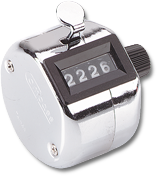
-
Encounter Calculator.
Made by AngefloSH, the Encounter Calculator is the best friend of a Shiny hunter. This tool lets you see the encounter tables of each location of each game, including multiple filters for repel trick hunts.
The tool is very intuitive and simple to use:
-
Select your game’s version. For this example, let’s use White 2.
-
Next, you need to choose the location under "Current map". We’ll go with the Seaside Cave, the basement floor in this case (B1F).
-
Under "Encounter type", there will appear the multiple ways you may find a wild Pokémon: grass, surfing, fishing, shaking grass, etc. In this case, as this is a cave, we’ll go with walking.
-
On the left, we can already see the list of Pokémon that appear, the "Encounter Slots data". With the information from that list, we can work out a repel trick level that we may be interested in, as well as other extra options like ability, time of day, season, lucky power, etc. Aside from a level 42 repel trick, we will also use Static for this tutorial.
-
When everything is ready, we can press "GO!" and we will be shown the results of our filtered search. Each Pokémon will be accompanied by their percentage of appearing, and at the bottom there will be the encounter rate. If the results are not ideal (or empty), we can always go back and choose different options.
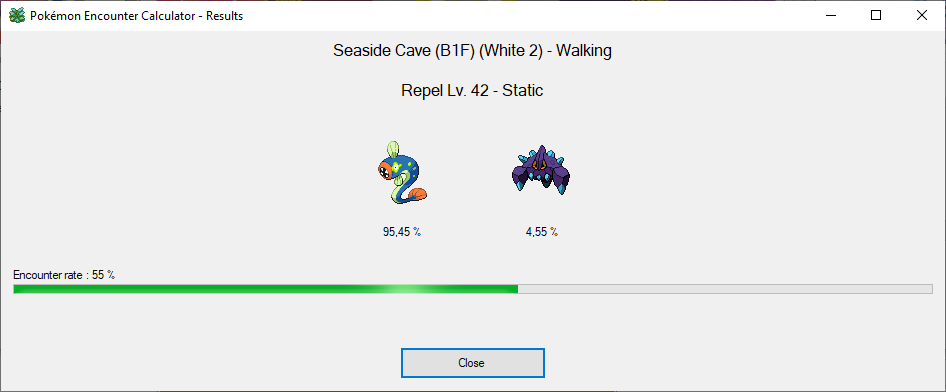
-
-
Spreadheets.
Spreadsheets are an easy way to maintain a list of all your previous and current hunts in a clean and organised way. A simple table with the target’s sprite, encounter number, game, date, and hour it appeared at, and other, more general things like the average. There are multiple programmes and services out there, but it’s always better to use free and open alternatives, like OpenOffice Calc or LibreOffice Calc.
7.3. Tips for hunting.
-
Planning the hunt (simple target):
One of the first steps before diving directly into hunting any random thing is planning the hunt itself a little bit, as there are some steps to take into consideration that depend on things like, for example, the game, the Pokémon, or the location. Some hunts are like a rough road, and a good plan is the passenger who knows how to traverse it. Preparing is sometimes half the fun, and going step by step is useful to have a clear view of the whole hunt. You may be wondering what "simple target" means here; let’s refer to this as a Pokémon that doesn’t require much preparation other than buying a few repels and specific Poké Balls or catching a Pokémon with Static or Magnet Pull.
First, and although it may sound obvious, let’s focus on choosing what to hunt. Let’s say we want to hunt in Emerald for a target boosted by Static, like Electrike. The target appears on multiple routes, so it’s better to check which of them has a higher chance of appearing with the help of internet resources like Wikis or the Encounter Calculator. A level 26 repel trick with Static on Route 118 gives a 38% (rounded up) chance of encountering both Electrike and Manectric each, with a not-so-bad encounter rate of 57%..
This time, the target could be boosted higher than its usual percentage, but this is not always true. If that’s the case with one of the targets you want, it doesn’t matter; phasing can make the hunt more thrilling when you get it.
The second step is optional, and some people may skip it entirely, but it’s nice to follow: colour matching the Poké Ball. Having a Shiny Pokémon caught in something that has a similar colour can make it look more eye-catching on the status screen. The limited number of Poké Balls makes it a bit difficult sometimes, but there are some clear choices that are worth considering, like Mew in a Dive Ball or Ninetales in a Heavy Ball. Electrike’s blue and yellow colour would go well with a Quick Ball, but it sadly didn’t come out until Generation 4. Evolving the Electrike could be the go-to option instead; Manectric would be a great fit for an Ultra Ball.
We can move on with the third step, checking if the target has any potentially dangerous moves or abilities. These are the ones that could damage or faint the Pokémon (recoil from Take Down or instant KO from self-destruct), end the battle prematurely (Whirlwind, Roar), be immune to status (Insomnia), etc. Here’s where you will choose your catcher and any other needed Pokémon with the strategy to make the hunt unable to fail. To continue with our example, Electrike doesn’t have any annoying abilities or dangerous moves at the level it appears at, and neither does Manectric. But this doesn’t end here. What if you get a Shiny Pokémon that isn’t your target? Checking them is also a must. Luckily, in this case, Zigzagoon, Linoone, and Wingull are safe, so we can move on.

After this, you´re all ready to hunt! Keep in mind that this is just meant to be a small checklist to guide you into finding your own routine before starting a hunt; what works for some doesn’t work for others. You can follow these steps for most of your hunts unless it’s something more specific, like eggs, where you will have to consider other things like the parents, the egg moves, and the egg cycles to hatch.
-
Planning the hunt (complex target):
There are other Pokémon that require a lot more preparation than normal or could be accompanied by other Pokémon that, even if they are not your main target, may appear in the same location and may be troublesome for the hunt. This also includes troublesome moves or abilities that may simply slow down your encounters.
We can follow the same steps as before. Let’s choose an unusual Pokémon for this example: Beldum. In Generation 4, Beldum can appear in the wild as a swarm in the Sinnoh games and in the Johto Safari Zone. We don’t want to risk the chance to flee, so Sinnoh will be the focus on this. Remember that you can follow the steps in the Swarms section of Generation 4 to "reset" until you get Beldum.

Diamond and Pearl Platinum 40% on Route 228 40% on Route 228 Diamond and Pearl (highest chance) Platinum (highest chance) 84.85% on Route 228 – Level 53 repel trick (+Magnet Pull)
82.5% encounter rate82.35% on Route 228 - Level 52 repel trick (+Magnet Pull)
42.5% encounter rateWith the help of some repel tricks and Magnet Pull, Beldum’s appearance rate can be highly increased in all games. Diamond and Pearl will be the clear choice here, though not for the small extra 2.5% chance it has over Platinum (in the end, that’s barely noticeable); it will be because of the encounter rate, with DP having almost double the amount.
Matching the Poké Balls will be the next step. Let’s take it one step further from the last section and also add the other possible Pokémon that can also appear with this repel trick.
Pokémon 




Poké Ball 

X X 

As mentioned in previous sections, colour matching a Poké Ball and a Shiny does not always work perfectly, and some Pokémon may not have a clear contender, just like Rhydon and Hippowdon in this case, so the choice is left to the reader’s judgement (or not; some Pokémon may not fit any Poké Ball, and that’s okay). For Beldum and Dugtrio, though, we can use some that may be a good suggestion. Dugtrio is also a good example of subtle matching; the blue from the nose (its most noticeable trait that differentiates it from the normal form) can be accentuated by using a blue Poké Ball like the Great Ball or the Dive Ball.
Here is the most important part, and why this is a more complex hunt than the previous example. Every single target here has at least one move that can put the hunt at risk of failing or make it annoying. All the potentially dangerous instances will be highlighted.
Pokémon Abilities Moves Notes 
Clear Body Take Down Only has one move with recoil damage 
Lightning Rod
Rock HeadEarthquake OHKO move Stone Edge Hammer Arm Horn Drill 
Sand Stream Double-Edge Can end the battle Earthquake Roar Crunch 
Sand Veil
Arena TrapFissure OHKO move
Ability prevents escapeEarthquake Slash Mud Bomb In order to bypass these problematic moves and abilities, the preparation has to be more in-depth, and it will require more brain power. These are some of the sets and strategies that can be used to counter them:
Drifblim

Data:
Ability: Unburden
Item: Leftovers
Moves:
Hypnosis
Trick
Pain Split
Drifblim’s interesting typing makes it immune to seven of the moves from the Pokémon that appear with this repel trick. Mainly, being a ghost makes it so Beldum always misses its Take Down and never receives recoil damage. Being a higher level would also work for any other Pokémon to avoid the OHKO moves, but it’s something you don’t have to worry about; they will always be ineffective. Being a flying type also lets it always run away from the annoying Arena Trap Dugtrio. Hypnosis is always helpful for inducing sleep status if you don’t want to risk using your preferred catcher. Leftovers help it tank the chip damage from the sandstorm each turn and also give it the chance to hand it to the wild Pokémon using Trick so they get a small passive recovery. Pain Split also works as a way to heal the target, especially with Drifblim’s high HP stat. Most of these moves are only available through tutors or breeding, so you may want to cut some corners and skip some of them. It can still work very well without them, but having all the support possible is welcome.
Always keep in mind that there may be other suitable options for the same task, which may be easier to obtain for you, appeal more to your liking, or come in handy in more than one hunt. Other examples of useful Pokémon for this example:
Gengar

Data:
Ability: Levitate
Item: Leftovers
Moves:
Hypnosis
Trick
Pain Split
Mismagius

Data:
Ability: Levitate
Item: Leftovers
Moves:
Trick
Pain Split
The following sections contain more important information and other tips that will help you build your own strategies for hunting specific targets.
-
Toolbox and Utily Pokémon.
There are some Pokémon and moveset combinations that are very useful, be it for general situations like travelling around the region with HMs or very specific situations like farming items from wild Pokémon. These sets are like a toolbox that will make your life easier. If you want to know more, check out the Utility Pokémon page.
-
Useful held items:
-
 Smoke Ball: allows you to run away
from a battle without having to worry about speed interactions, especially while using a repel
trick or hunting during the playthrough. In some games, the item also adds a special animation while fleeing.
Smoke Ball: allows you to run away
from a battle without having to worry about speed interactions, especially while using a repel
trick or hunting during the playthrough. In some games, the item also adds a special animation while fleeing.
-
 Leftovers: passive recovery can be a
lifesaver in some situations, especially when paired with Trick, so the wild Pokémon gets that small heal each turn.
Leftovers: passive recovery can be a
lifesaver in some situations, especially when paired with Trick, so the wild Pokémon gets that small heal each turn.
-
 Leppa Berry: sometimes HP is not as worrysome as PP,
and that’s what this berry is the best at: recovering 10 PP from one move.
Paired with Trick and Recycle, it can make the Shiny Pokémon never run out of PP.
Leppa Berry: sometimes HP is not as worrysome as PP,
and that’s what this berry is the best at: recovering 10 PP from one move.
Paired with Trick and Recycle, it can make the Shiny Pokémon never run out of PP.
-
 Wide Lens: gives a 10% boost to the accuracy
of the moves of the Pokémon holding the item. It brings moves like Hypnosis from
60% to 66% or Sleep Powder from 75% to 82.5%. Situational item.
Wide Lens: gives a 10% boost to the accuracy
of the moves of the Pokémon holding the item. It brings moves like Hypnosis from
60% to 66% or Sleep Powder from 75% to 82.5%. Situational item.
-
 Silk Scarf:
increases the power of normal-type moves by 10% (20% from Generation 4 onwards). It is useful for False Swipe users to get
an extra boost to the damage.
Silk Scarf:
increases the power of normal-type moves by 10% (20% from Generation 4 onwards). It is useful for False Swipe users to get
an extra boost to the damage.
-
-
Counter strategies against dangerous or tedious situations:
-
Dangerous moves: there are multiple moves that a wild Pokémon can use that make them instantly KO themselves, end the battle, get damaged by recoil... There are way too many of them to go on about each of them one by one, so you can check their own section, the Dangerous Move Checker, which also has a list of all the moves and ways to counter them. Keep in mind that some recoil moves may not have a solution in these old generations, and the best option is using a high-level Pokémon that resists these moves.
-
Sticky Barb: some Pokémon through the games have a 5% chance of holding a Sticky Barb in the wild. This item takes ⅛ of their HP per turn, as long as they have it. These Pokémon are Cacnea (DPPt, HGSS), Cacturne (DPPt, HGSS, B2W2), and Ferroseed (BW, B2W2). In order to get rid of it, you can use moves like Trick, Bestow, or Switcheroo to swap items between the wild Pokémon and yours. Thief is also a possible option, although it deals damage. Frisk can help identify if they are actually holding the item before they get damaged from it. Heal Pulse is another option if you’re worried about Sand Veil and missing Trick, as Heal Pulse bypasses accuracy checks.



-
Rage Powder: in some very specific situations, like a wild level 54 Amoonguss, Rage Powder can be dangerous during a double battle, making you knock out the wrong Pokémon. The easiest way to manage this move is with Taunt.
-
Arena Trap/Shadow Tag: these abilities prevent you from fleeing, forcing you to fight the Pokémon and knock it out before moving on to the next encounter. The ability Run Away lets you flee from any wild battle, regardless of these trapping abilities. Flying-type Pokémon and those with the Levitate ability are immune to Arena Trap. Keep this in mind if you are using these trapping abilities yourself as well; some Pokémon, like Natu, will be able to use Teleport to end the battle anyway.

A Dugtrio preventing the escape 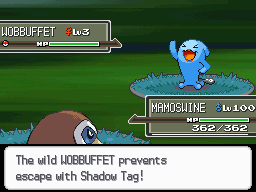
A Wobbuffet preventing the escape -
Sketch: Smeargle will only know one move in the wild: Sketch, a 1 PP move that copies the last move used. After using Sketch, if the wild Smeargle fails to copy a move, it will start using Struggle and faint itself. The best way to counter this is by using a high-PP move, such as Foresight, before Smeargle can act.
-
Spore immunity: some Pokémon may have an ability that prevents them from being put to sleep, like Insomnia. The ability can be removed or swapped with Skill Swap or Entrainment, which is a better solution than just paralysing them.
-
Confusion: through the use of Outrage, Petal Dance, or Thrash, a Pokémon may become confused at the end of its attacks, which will potentially put them in danger. Heal Pulse can be used to heal their HP if they hit themselves.
-
Skill Swap + Wonder Guard: prevents the wild Pokémon from taking damage from indirect sources like status or weather. Only possible in Generation 5. It is useful to fix accidental mistakes like inflicting the Shiny with poison or burn, or to protect it from Hail or Sandstorm. Sigilyph and the Reuniclus line can have this combo.
-
Trick/Switcheroo/Bestow + Item: using the move Trick to give the wild Pokémon an item that will keep it alive longer or just make its capture easier. Some examples of this include: Leftovers to heal Struggle’s damage (in some generations).
-
Struggle (before Generation 4): it will deal recoil damage to the user, which will be 25% of the damage dealt (Generations 2 and 3), and it was changed after the Sinnoh games, where the Pokémon loses 25% of their max HP with each use. This means that before Generation 4, you could decrease the recoil to a minimum by having a high-level and/or high-defense Pokémon tank the hits. Lowering the accuracy or increasing the evasion also works, as it’s not until Generation 4 that it can’t miss. Mix that with Trick + Leftovers, and you can have a near-infinite battle.
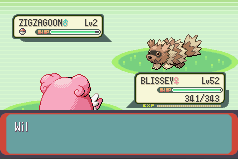
Struggle can miss... 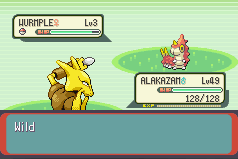
...and Leftovers can heal the recoil damage! -
Healing Moves: this includes any move that heals the user directly, like Recover, Milk Drink, Soft-Boiled, or Heal Order; moves that heal a percentage of the damage dealt, like Giga Drain, Leech Life, or Dream Eater; and moves that heal per turn, like Ingrain or Aqua Ring. The best answer to all these moves is Heal Block, which not only blocks the first group of moves (just like Taunt would do), but also all the others, even something like Leech Seed (those moves can be used and can deal damage, but won’t heal). For anything before Generation 4, where Heal Block didn’t exist yet, Taunt is the best thing there is.
-
-
Type and weather interactions, and other traits to keep in mind:
-
Ice-type Pokémon don’t receive any damage from Hail. Pokémon with one of the following abilities are also unaffected by Hail: Snow Cloak, Overcoat, and Magic Guard.
-
Rock, ground, and steel-type Pokémon don’t receive any damage from Sandstorm. Pokémon with one of the following abilities are also unaffected by Sandstorm: Sand Veil, Sand Rush, Sand Force, Overcoat, and Magic Guard. Since Generation 4, the special defense of rock-type Pokémon is increased by 50% in Sandstorm.
-
Pokémon with the Dry Skin ability will lose 12.5% of their HP per turn in sunny weather. On the other hand, they will recover the same amount of HP in the rain.
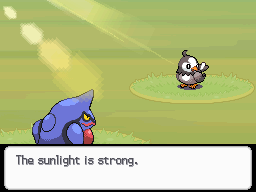
Under the sunlight... 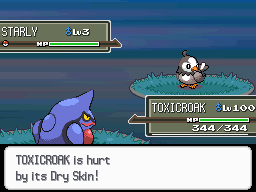
...Dry Skin makes the Pokémon lose HP! 
On the other hand, under the rain... 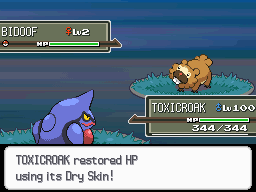
...Dry Skin makes them recover the same amount! -
Fire-type Pokémon can’t be burned, except in Generations 1 and 2 through the use of Tri-Attack. The same principle applies to ice types and being frozen.
-
Ground-type Pokémon can be paralysed with Stun Spore.
-
Grass-type Pokémon can be targeted by powder and spore moves like Spore, Stun Spore, Sleep Powder, Rage Powder, etc.
-
Electric-type Pokémon are not immune to being paralysed.
-
Poison and steel types are immune to being poisoned, except when using Twineedle in Generation 2.
-
Fog decreases the accuracy of all Pokémon by 40%. Forget about your 100% accurate moves. This weather appears on some of Sinnoh’s locations (Lost Tower, Route 210, Victory Road, Mt. Coronet, and Turnback Cave). Any other location with this weather in the overworld is just aesthetic and will not drop the accuracy. It can be removed with Defog.
-
7.4. Maxing out your Shiny.
-
Shiny Leaf.
Exclusive to HeartGold and SoulSilver, but totally worth it if you have a Shiny in that game. A Shiny Leaf is an item that can only be obtained while walking with your Pokémon; they will randomly find this item while taking a stroll in tall grass in some spots of the regions. These leaves will appear in the status screen of the Pokémon and can be stacked up to a total of 5. The locations where they can be found will depend on the nature of the Pokémon:
Natures Leaf 1 routes Leaf 2 routes Leaf 3 routes Leaf 4 routes Leaf 5 routes Hasty, Mild, Quirky, Rash 44 39 26 18 11 Calm, Gentle, Lax, Relaxed 32 35, 48 2, 28 4 6 Impish, Jolly, Naive, Naughty, Sassy 31 34, 47 1 3 5, 12 Careful, Docile, Modest, Quiet, Serious 33 36 45 7 8, 13, 14 Adamant, Bold, Brave, Hardy 42 37 22, 46 15 9, 24 Bashful, Lonely, Timid 43 38 27 16 10, 25 As a side note, flying-type Pokémon won’t be able to find a leaf on Route 47.
The Pokémon will have an exclamation mark, move around, and end with a green musical note when it finds a leaf. After finding the first leaf, you can go show it to the New Bark Town friend (Ethan or Lyra), and they will tell you about it. After finding the fifth leaf, they will make a crown out of them, and it will be displayed on the status screen. You will also receive a special diploma in honour of the journey you took with your Pokémon. As a bonus fun fact, this diploma shows the Shiny sprite of your Pokémon and can be seen at any time by speaking with Ethan or Lyra again.
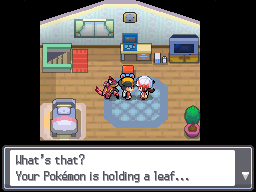
You will hear about the Shiny Leaf you found. 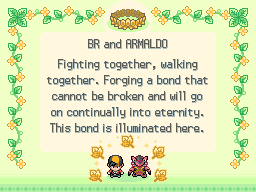
After obtaining all five, you will receive a diploma.



